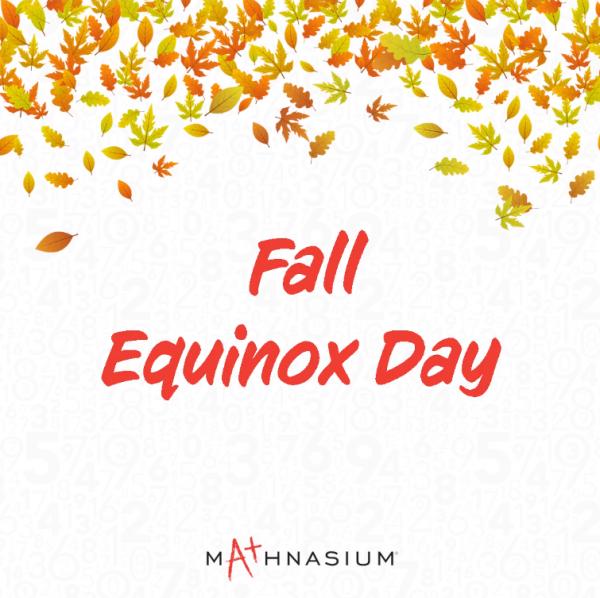Back-to-school season is upon us, and with it comes the end of summer. To make it official, today we are celebrating the Fall Equinox!
Also known as the Autumn Equinox, September 22, 2021, marks the First Day of Fall. But what does this mean?
Let’s start with some basics about Earth.
Earth is split into two hemispheres, North and South.
A hemisphere is half of a sphere. Earth’s hemispheres are divided by the equator, defined as a Great Circle located at 0-degrees latitude.
Earth spins on a tilted axis.
“An axis is an invisible line around which an object rotates (or spins). The points where an axis intersects with an object’s surface are the object’s North and South Poles.”1 Rather than spinning on a 0-degree tilt, the Earth’s axial tilt is about 23.5 degrees. Earth completes one full spin about its axis in 24 hours, giving us day when the Northern Hemisphere faces the Sun and night when facing away from the Sun.
Earth rotates around the Sun on its axial tilt.
In fact, the axial tilt determines our seasons as the Earth rotates around the Sun. Earth’s orbital period is about 365 days, during which it completes one full rotation around the Sun. We experience winter in the Northern Hemisphere when the North Pole is tilted away from the Sun (losing warmth) during this full rotation; alternatively, we experience summer in the Northern Hemisphere when the North Pole is tilted towards the Sun (gaining warmth).
All of this brings us the Equinoxes. The lengths of our days and nights are not usually equal except for two days in a year: the Spring and Fall Equinox Days. Equinox stems from the Latin words for “equal” (aequus) and “night” (nox). During the 24-hour day on the two Equinoxes, we can expect roughly half of the day (12 hours) to be day and the second half of the day (another 12 hours) to be night.
Officially, the Equinox marks the moment when the Sun is in line with the equator, representing for us an official change in season. When an Equinox happens, the dividing line between the light and dark parts of the Earth extends directly through the North and South Poles.
So, does everyone across the world celebrate the first day of Fall today?
The answer is no. Since the Fall Equinox represents the time in the North when the Sun’s centre passes the celestial equator from north to south and the Northern Hemisphere continues to tilt away from the Sun, it likewise represents the time of year when the Southern Hemisphere continues to tilt towards the Sun. Whereas in the Northern Hemisphere we celebrate the Fall Equinox in September and the Spring Equinox in March, the Southern Hemisphere celebrates the Spring Equinox in September and the Fall Equinox in March!
Did you know?
- Not all locations on Earth experience equinoxes. Regions on or near the equator do not experience equinoxes because they have roughly equal days and nights throughout the entire year.
- The two Equinoxes occur roughly the same time each year on Earth. The first phenomenon occurs between March 20-23 and the second between September 20-23. You can find the exact day and time here.
- Although equinox derives from the Latin words for equal night, we do not experience perfectly equal daylight and nighttime during the Equinoxes. Click here to follow the amount of daylight in your area.
- All planets experience Equinoxes! However, because all planets spin on different tilted axes, have different orbital periods, and spin about their axes at various speeds, they experience Equinoxes at other parts of our year. For example, Saturn’s axial tilt is 27 degrees (relative to the Sun), and the planet takes about 30 years to orbit around the Sun; this means the planet sees an Equinox once every 15 years.
- The two times a year when the Earth’s poles are closest and farthest from the Sun are called the Solstices. Following the Fall Equinox in the Northern Hemisphere, daylight hours continue to shorten until the Winter Solstice — the time of year when the North Pole is tilted farthest from the Sun. After the winter solstice, we approach the Spring Equinox, followed by the Summer Solstice, when the North Pole is tilted closest to the Sun.
- Trees can tell when Fall is here! Around this time of year in the North, we notice green leaves beginning to turn beautiful orange and red colours. Although weather conditions can impact the intensity of fall colours, the transformation in colour is not a result of temperature change but rather the decreased amount of daylight; therefore we notice the change of colours at the same time each year. As the days grow shorter, “deciduous (green leafy) trees start signaling to their leaves to stop producing chlorophyll, the green pigment responsible for the leaves’ colour and photosynthesis.”2
How do you and your family celebrate the change in season?
Sources:
1. Caryl-Sue, National Geographic Society (2012). Axis. National Geographic: Resource Library Encyclopedic Entry. Retrieved from https://www.nationalgeographic.org/encyclopedia/axis/
2. Resnick, B. (2018). When and where fall foliage colors will peak, in one map. Vox. Retrieved from https://www.vox.com/energy-and-environment/2018/9/4/17800200/peak-fall-foliage-2018-map

 877-601-6284
877-601-6284 877-601-6284
877-601-6284





















